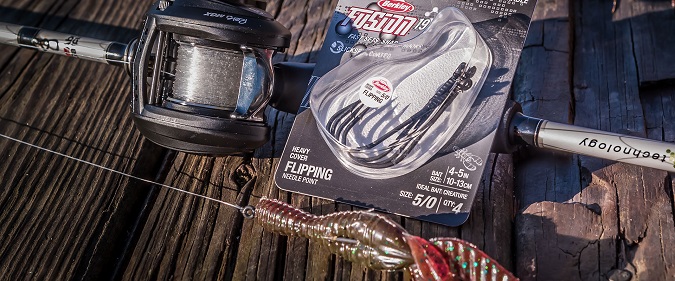Summer is a great time to target bass. Sag-bellied largemouths and smallies slide into predictable post-spawn patterns that allow savvy bass fans to enjoy great fishing on a variety of lakes virtually across the U.S. and southern Canada.

Berkley pro Justin Lucas knows the drill.
The lifelong bass junkie earned his stripes on the diverse fisheries of northern California, and currently crisscrosses the continent competing on the Bassmaster Elite Series.
“Summer patterns are pretty universal,” he explains. “It’s a matter of identifying the best combinations of food, cover and structure that a particular lake has to offer, and then figuring out the most effective presentations for fishing each situation.”
To help anglers nationwide savor more hookups this summer, Lucas offers a trio of his favorite strategies for putting bass in the boat.
#1 Green Party
“Largemouth bass love vegetation, from shoreline slop to offshore weedbeds,” he says. “If conditions are right, they’ll set up in the grass and stay there all summer.”
One of Lucas’ pet presentations for plying productive salad is a relatively flat-bodied bug- or beaver-style soft plastic like Berkley’s 4½-inch Havoc Change Up.
“It’s perfect for flipping into weedy cover,” he explains. “The split tail and wriggly appendages give the bait plenty of bass-attracting action, both on the drop or when you barely shake it.”
Lucas typically rigs the Change Up Texas-style on a 4/0 Heavy Cover Berkley Fusion19 hook. “It works really well on a jig, too,” he notes. “Go with the system you’re most comfortable fishing.”
TACKLE TIPS: How to Tie a Palomar Knot
When Texas-rigging, he threads a ¼- to 1-ounce sliding sinker on 20-pound Berkley Trilene 100% Fluorocarbon mainline, ties on the hook and pegs the sinker tight to the knot. “I like throwing this rig on a 7½-foot, heavy baitcasting outfit,” he says, explaining the setup engenders pinpoint pitches and total control over the presentation, while providing ample firepower for hooking and fighting big bass in thick cover.
Lucas works quickly and methodically through prime lies. “Flip the bait out and let it fall to bottom,” he says. “A lot of times bass hit on the first fall. Don’t expect a crushing strike, though. Bites often register as nothing more than a soft and spongy feeling on the line.”
However the fish hits, Lucas advises setting the hook immediately. “Set hard, right away,” he says. “Then get the bass moving up and out of the cover.”
If nothing bites on the first drop, Lucas recommends using your rod tip to raise the bait slightly off bottom and shake it once or twice. “If you don’t get bit, reel in and flip it out to the next spot,” he says.
Lucas notes that the technique works in weeds thick and thin, as well as around laydowns and in shady areas under docks. “Finding isolated spots that concentrate bass is the key,” he adds.
#2 Feeling Shaky
When largemouths and smallmouths roam offshore weedlines and rocky structure, Lucas leans on a slightly shakier approach.
“Twitching a slender soft bait along bottom on a shaky head jig imitates crayfish and other forage, triggering strikes from bass that pass up crankbaits and other faster-moving presentations,” he explains.
His go-to is a 5-inch Berkley PowerBait Shaky Snake. “The bait has a lot going for it,” he explains. Indeed, Berkley designers graced it with unique, corkscrew ribs to give the slender body and cone-shaped tail a subtle, undulating action.
“The ribs also create more surface area, which aids in the delivery of PowerBait scents and flavors,” he adds. “This encourages bass to hang onto it longer than they would other baits.”
For this tactic, Lucas switches to a 7-foot, medium-heavy spinning outfit spooled with 8-pound Berkley Trilene 100% Fluorocarbon. Water depth dictates jig weight, with common sizes ranging from 1/8- to ¼-ounce. Thin wire hooks aid in hook-setting, while the angle of the head affects bait action and resistance to snags. In general, 90-degree heads enhance shaking, while 60-degree heads tend to slide more cleanly across structure.
Once you’re rigged up and in position, Lucas advocates fishing the shaky setup with a slow hand. “Cast out, let the jig land and slowly move it along bottom, shaking it with the rod tip,” he explains, noting that the approach also works wonders in shallower strike zones such as around docks.
#3 Tube Time
For summer smallmouths, Lucas also favors the time-tested tube jig. “Drop-shotting is deadly, too, but it pays to always have a tube rod rigged up, so you can show the bass something different,” he says.
TACKLE TIPS: Dropshotting Made Simple
Tube jigs excel at imitating crayfish, which drives smallies crazy. Lucas’ top choice is Berkley’s PowerBait Power Tube. Along with tantalizing tentacles and PowerBait scents and flavors, it features a slightly flattened torso, which yields a smooth glide on the fall.
Tubes are extremely versatile baits, allowing a variety of retrieves ranging from basic bottom dragging to variations of swimming, shaking, bouncing and deadsticking—along with combinations of all five. Lucas recommends experimenting with different moves, without getting overwhelmed. “The simplest approach is to drag the tube across the bottom, similar to a shaky head,” he says. “That will put smallmouths on the line all season long, everywhere in the country.”
